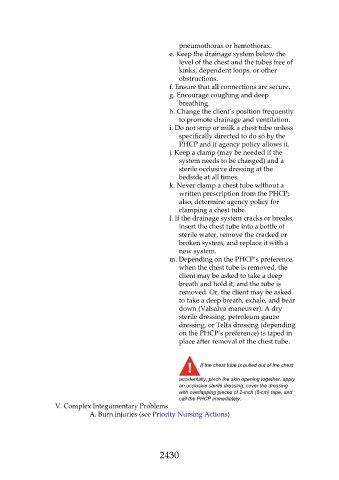Page 2430 - Saunders Comprehensive Review For NCLEX-RN
P. 2430
pneumothorax or hemothorax.
e. Keep the drainage system below the
level of the chest and the tubes free of
kinks, dependent loops, or other
obstructions.
f. Ensure that all connections are secure.
g. Encourage coughing and deep
breathing.
h. Change the client’s position frequently
to promote drainage and ventilation.
i. Do not strip or milk a chest tube unless
specifically directed to do so by the
PHCP and if agency policy allows it.
j. Keep a clamp (may be needed if the
system needs to be changed) and a
sterile occlusive dressing at the
bedside at all times.
k. Never clamp a chest tube without a
written prescription from the PHCP;
also, determine agency policy for
clamping a chest tube.
l. If the drainage system cracks or breaks,
insert the chest tube into a bottle of
sterile water, remove the cracked or
broken system, and replace it with a
new system.
m. Depending on the PHCP’s preference,
when the chest tube is removed, the
client may be asked to take a deep
breath and hold it, and the tube is
removed. Or, the client may be asked
to take a deep breath, exhale, and bear
down (Valsalva maneuver). A dry
sterile dressing, petroleum gauze
dressing, or Telfa dressing (depending
on the PHCP’s preference) is taped in
place after removal of the chest tube.
If the chest tube is pulled out of the chest
accidentally, pinch the skin opening together, apply
an occlusive sterile dressing, cover the dressing
with overlapping pieces of 2-inch (5-cm) tape, and
call the PHCP immediately.
V. Complex Integumentary Problems
A. Burn injuries (see Priority Nursing Actions)
2430

